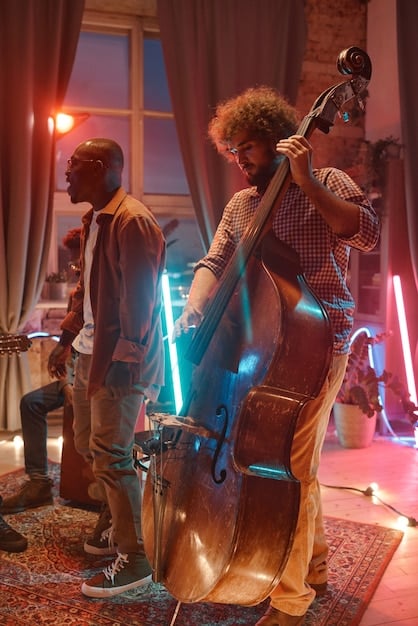Beyond Spotify: Platforms for Emerging Artists

Navigating the digital music landscape can be challenging for emerging artists, but exploring a diverse range of alternative streaming platforms beyond mainstream giants like Spotify offers unique opportunities for greater reach, fairer revenue, and genuine fan engagement.
In today’s dynamic music industry, the journey for an artist often begins with getting their sound heard. While Spotify undeniably dominates the streaming landscape, limiting your presence to a single platform could mean missing out on significant opportunities. Understanding the landscape of Beyond Spotify: Alternative Streaming Platforms Emerging Artists Need to Know Now is crucial for cultivating a sustainable and thriving career.
The Shifting Tides of Music Consumption
The digital revolution fundamentally transformed how we consume music. From physical media to digital downloads and now ubiquitous streaming, the paradigm continues to evolve rapidly. For emerging artists, this evolution presents both distinct challenges and unprecedented opportunities.
Initially, digital distribution was about breaking free from the gatekeepers of traditional labels and physical retailers. Now, the challenge lies in standing out amidst an ocean of content. Spotify, Apple Music, and Amazon Music have become the de facto storefronts, but their sheer scale can make it difficult for new voices to emerge.
Understanding the Dominance of Major Platforms
Major streaming platforms offer unparalleled reach and user bases. They are often the first stop for listeners seeking new music, offering curated playlists and algorithmic recommendations that can expose artists to millions. However, this reach comes at a cost, often in the form of low per-stream payouts and fierce competition for visibility.
- Algorithmic challenges: Getting noticed by algorithms on major platforms requires massive streams and engagement, a chicken-and-egg situation for new artists.
- Revenue splits: The per-stream royalty rates are notoriously low, making it difficult to generate substantial income solely from these platforms, especially without millions of plays.
- Data transparency: While some data is provided, deeper insights into fan demographics and listening habits can be limited compared to more artist-centric platforms.
Consequently, while maintaining a presence on these platforms is often a necessity, a strategic approach looks beyond them. Diversifying your digital footprint can mitigate risks and unlock new avenues for growth that are often overlooked by focusing solely on the giants. It’s about building a robust ecosystem for your music.
The goal is to cultivate direct relationships with fans and explore platforms that align more closely with an artist’s specific genre, community, or financial goals. This proactive approach not only helps in reaching new listeners but also in establishing a more resilient long-term career strategy in a constantly changing industry.
Bandcamp: A Beacon for Artist-Centric Revenue
When discussing alternatives, Bandcamp invariably comes to the forefront. It stands out as a platform built with artists’ livelihoods in mind, offering a stark contrast to the revenue models of many larger streaming services. For emerging artists, this can translate into a significantly more viable income stream.
Bandcamp operates on a “name your price” model, allowing fans to pay more than the minimum price for digital tracks and albums. This flexibility empowers fans to directly support artists they love, fostering a deeper connection and a sense of shared community around the music itself. The platform takes a respectable 10-15% cut of digital sales, and a slightly higher percentage for physical merchandise, leaving the vast majority of revenue with the artist.
Beyond Digital Sales: Physicals and Community
One of Bandcamp’s strongest features is its integrated storefront for physical merchandise. Artists can sell vinyl, CDs, cassettes, and even custom apparel directly through their Bandcamp page, streamlining the entire process from creation to fulfillment. This not only adds another revenue stream but also caters to fans who prefer tangible forms of music ownership.
- Fan ownership: Fans who purchase directly own the music, fostering a sense of investment in the artist’s journey.
- Merchandise integration: Seamlessly sell physical products alongside digital releases, consolidating your storefront.
- Bandcamp Fridays: On the first Friday of every month, Bandcamp waives its revenue share, ensuring 100% of sales go directly to the artists and labels. This initiative has funneled millions of dollars directly into the artist community.
Moreover, Bandcamp functions as a vibrant community hub. Artists can post updates, engage with fans through comments, and share insights into their creative process. This interaction builds loyalty and transforms casual listeners into dedicated supporters. The platform’s emphasis on discovery, through curated recommendations and genre-specific tags, also helps niche artists find their audience.
For artists prioritizing direct fan support and fair compensation, Bandcamp remains an indispensable part of their distribution strategy. Its transparent model and community-focused features empower artists in ways that larger, more commercial platforms often struggle to replicate. It’s a place where artistic integrity and financial viability can truly coexist.
SoundCloud: Discovery and Direct Uploads

SoundCloud has carved out a unique niche as a pioneering platform for audio sharing and discovery. While it has evolved significantly since its inception, it remains a powerful tool for emerging artists, particularly those focused on building an initial listener base and fostering direct engagement.
Its primary strength lies in its user-friendly upload system and social features. Artists can upload tracks with ease, often before formal distribution, allowing for quick feedback and immediate sharing. This makes it an ideal testing ground for new material or for sharing exclusive demos and remixes that might not fit a traditional release schedule.
Community and Engagement on SoundCloud
SoundCloud’s comment system, which allows users to leave time-stamped comments directly on the audio waveform, facilitates a uniquely interactive listening experience. This direct feedback can be invaluable for artists, providing insights into specific moments in their tracks that resonate with listeners or need improvement.
- Direct uploads: Publish music instantly, bypassing traditional distribution channels for quick sharing and feedback.
- Interactive comments: Engage with listeners directly on specific parts of your tracks via waveform comments.
- Reposts and likes: Organic sharing through reposts helps artists gain visibility within the SoundCloud community and beyond.
While SoundCloud’s monetization options for independent artists have varied over time, its role as a discovery platform remains robust. Many artists have launched careers by gaining initial traction on SoundCloud before expanding to other platforms. It’s often the first place talent scouts and industry professionals look for fresh sounds.
Furthermore, SoundCloud offers analytics tools that provide insights into audience demographics and listening habits, helping artists understand who is listening to their music and where. This data can inform future marketing strategies and artistic direction. For hip-hop, electronic, and experimental artists, in particular, SoundCloud continues to be a vital ecosystem for audience cultivation and creative expression.
Despite increased competition, SoundCloud retains its relevance by fostering a more informal and experimental approach to music sharing. Its community-driven features and emphasis on direct communication make it an invaluable asset for artists seeking organic growth and authentic connection with their listeners.
YouTube: Visuals, Community, and Monetization
Often perceived solely as a video-sharing platform, YouTube is, in fact, one of the world’s largest music streaming services. For emerging artists, leveraging YouTube goes far beyond simply uploading music videos; it’s about building a visual brand, fostering a community, and unlocking significant monetization opportunities.
The visual component of YouTube allows artists to tell their story, showcase their personality, and create a deeper connection with their audience. From official music videos and lyric videos to live performances, behind-the-scenes content, and vlogs, the possibilities for creative expression are vast, offering diverse entry points for fan engagement.
Monetization and Discovery on YouTube
YouTube’s monetization system, through AdSense revenue, channel memberships, merchandise shelves, and Super Chat, provides multiple avenues for artists to earn directly from their content. While ad revenue can be modest for smaller channels, consistent content creation and audience growth can lead to substantial income over time.
- Diverse content formats: Beyond music videos, leverage live streams, vlogs, and behind-the-scenes content to engage fans.
- Multiple revenue streams: Earn from ads, channel memberships, merchandise, and direct fan contributions.
- Global reach and discoverability: YouTube’s immense user base and powerful search engine make it a prime platform for global audience discovery.
YouTube’s robust search engine and recommendation algorithms are powerful discovery tools. Optimizing video titles, descriptions, and tags with relevant keywords helps music reach new listeners. Engaging with comments and fostering a community section further strengthens fan loyalty and encourages organic sharing.
For independent artists, YouTube offers a comprehensive platform to build a brand, connect with fans globally, and diversify income. It requires a commitment to consistent content creation and understanding SEO for videos, but the payoff in terms of exposure and direct revenue can be transformative. It’s an essential pillar in any artist’s digital strategy, bridging the gap between audio and visual storytelling.
Audiomack: Hip-Hop, Electronic, and Youth Culture

Audiomack has established itself as a go-to platform, particularly within the hip-hop, R&B, electronic, and youth culture segments. It operates on a freemium model, allowing artists to upload music, podcasts, and other audio content for free, while offering premium features for both creators and listeners.
Its strength lies in its focus on new and trending music, serving as a pulse for what’s breaking in specific genres. Artists can gain rapid exposure through its trending charts and curated playlists, which are highly influential within its core user base. This makes it an ideal platform for artists looking to make an immediate impact within these communities.
Monetization and Data Insights on Audiomack
Audiomack offers a robust monetization program called “Monetization for All,” which allows eligible artists to earn revenue from their streams, similar to how traditional streaming services operate. This program typically has eligibility requirements, but it provides a tangible path to income for artists on the platform.
- Trending charts: Opportunity for rapid exposure through genre-specific and overall trending charts.
- “Monetization for All”: Earn revenue from streams once eligibility criteria are met.
- Advanced analytics: Gain insights into listener demographics, geographic reach, and listening habits to refine marketing efforts.
Beyond monetization, Audiomack provides comprehensive analytics dashboards that give artists deep insights into their audience. Understanding where listeners are located, how they discover music, and which tracks resonate most can be incredibly valuable for targeted marketing and tour planning.
For producers, DJs, and artists who primarily create remixes or instrumental tracks, Audiomack also offers robust features for sharing and collaborating. Its intuitive interface and mobile-first approach resonate strongly with a younger demographic, making it a powerful platform for reaching the next generation of music consumers. It’s a crucial platform for artists whose sound aligns with its vibrant user base.
Niche Platforms and Direct-to-Fan Models
While the previously mentioned platforms offer broad appeal, a strategic artist also considers niche streaming services and direct-to-fan (D2F) models. These alternatives may not boast millions of users, but they often provide highly engaged communities, better per-stream rates, or unique opportunities for fan interaction and loyalty. This diverse approach ensures an artist is less reliant on any single revenue stream or discovery algorithm.
Exploring platforms tailored to specific genres, such as Beatport for electronic music or platforms like Mixcloud for DJs and radio shows, can connect artists with a highly targeted and appreciative audience. These niche platforms often foster strong communities where fans are more willing to invest directly in the artists they love.
Patreon and Membership Models
Beyond traditional streaming, direct-to-fan platforms like Patreon represent a significant paradigm shift. Patreon allows artists to create subscription-based memberships, offering exclusive content and experiences to their most dedicated fans in exchange for recurring financial support. This model fosters a deeper, more direct relationship between creator and supporter, moving beyond transactional streams.
- Exclusive content: Offer demos, early releases, behind-the-scenes access, or personal interactions.
- Recurring revenue: Build a stable income stream independent of fluctuating stream counts.
- Community building: Cultivate a core group of highly engaged, financially supportive fans.
This approach prioritizes quality over quantity, encouraging artists to build a loyal fan base that actively participates in their journey rather than passively consuming their music. It’s an empowering model for artists seeking creative freedom and sustainable careers, bypassing many of the industry’s traditional challenges.
Moreover, embracing personal websites with integrated e-commerce features allows artists to maintain complete control over their branding, sales, and fan data. Selling directly from their own site gives artists 100% of the revenue, provides invaluable customer insights, and reinforces their independent identity. Diversifying across niche platforms and embracing D2F models is about building a resilient and sustainable career path.
This multi-platform strategy mitigates the risks associated with relying solely on major streaming services. It allows artists to tap into various revenue streams, engage with different fan segments, and experiment with diverse content formats, ultimately building a more robust and future-proof music career.
Building a Multi-Platform Strategy for Longevity
For independent artists, success in the digital age is rarely found on a single platform. Instead, it lies in strategically building a diversified presence across multiple platforms, each chosen for its unique benefits in terms of reach, revenue, and community engagement. This multi-platform approach creates a resilient ecosystem for your music, reducing reliance on any single giant.
The goal is to understand how each platform complements the others, forming a cohesive strategy. For instance, YouTube might be your primary visual hub, while Bandcamp serves as your direct sales portal, and SoundCloud acts as a space for unreleased demos and community feedback. Each platform plays a role in attracting different types of listeners and achieving specific strategic objectives.
Key Elements of a Smart Multi-Platform Approach
Effective multi-platform deployment isn’t just about uploading your music everywhere; it’s about optimizing your presence on each chosen service. This involves tailoring your content, engaging with specific communities, and leveraging the unique features of each platform.
- Content diversification: Adapt your content to suit each platform (e.g., short clips for TikTok, full tracks for Bandcamp, videos for YouTube).
- Cross-promotion: Use each platform to drive traffic and awareness to your other profiles and your website.
- Analytics review: Regularly analyze data from all platforms to understand audience behavior and refine your strategy.
Ultimately, a successful multi-platform strategy is about empowering the artist. It’s about creating more avenues for fans to discover, consume, and support your music, while simultaneously giving you more control over your income and creative direction. By looking beyond the obvious, emerging artists can build a more sustainable and fulfilling career in music.
This strategic diversification moves beyond simply “being everywhere” to being “smart everywhere.” It involves a thoughtful analysis of where your potential audience resides, how they prefer to engage with music, and which platforms offer the most favorable terms for artists. This proactive approach is key to navigating the evolving digital music landscape and ensuring your artistry thrives for years to come.
| Key Point | Brief Description |
|---|---|
| 💸 Fairer Revenue | Platforms like Bandcamp offer artists significantly higher revenue shares compared to major streaming services. |
| 🌐 Targeted Reach | Niche platforms (e.g., Audiomack) and D2F models (e.g., Patreon) help artists connect with highly engaged, specific fan bases. |
| 🤝 Direct Engagement | Platforms such as SoundCloud and YouTube foster direct artist-fan interaction and community building. |
| 📈 Diversified Income | Combining various platforms creates multiple revenue streams, contributing to a more sustainable music career. |
Frequently Asked Questions
▼
While Spotify offers broad reach, emerging artists often face low per-stream royalties and fierce competition for visibility. Exploring alternatives allows for better revenue splits, direct fan engagement, and reaching niche audiences who may be more inclined to support artists directly through purchases or subscriptions.
▼
Bandcamp is known for its artist-friendly revenue model, allowing artists to keep a significant percentage (85-90%) of sales for digital music and merchandise. It fosters direct fan support, offers “name your price” options, and has “Bandcamp Fridays” where all revenue goes directly to the artists, building a strong community.
▼
Absolutely. YouTube is one of the largest music streaming services globally. It offers diverse monetization options through ads, channel memberships, and merchandise. Its visual appeal allows artists to connect with fans through music videos, live performances, and behind-the-scenes content, building a strong visual brand.
▼
A D2F model, exemplified by platforms like Patreon, allows artists to connect directly with fans for financial support or exclusive content. It builds stronger relationships, provides recurring revenue streams independent of stream counts, and offers creative freedom by lessening reliance on traditional industry gatekeepers.
▼
A multi-platform strategy diversifies reach, revenue, and engagement. By leveraging various platforms like Bandcamp for sales, YouTube for visuals, and SoundCloud for discovery, artists can tap into different audiences, mitigate risks, and build a more resilient and sustainable career in the evolving digital music landscape.
Conclusion
The journey for an emerging artist in the digital age is complex, requiring both creativity and strategic thinking. While Spotify holds an undeniable position in the streaming world, a singular focus on it can be limiting. The true opportunity lies in looking Beyond Spotify: Alternative Streaming Platforms Emerging Artists Need to Know Now. By embracing a multi-platform strategy that includes artist-friendly platforms like Bandcamp, discovery hubs like SoundCloud, visual powerhouses like YouTube, and direct-to-fan models such as Patreon, artists can build a more resilient, diversified, and ultimately, more sustainable career. The future of music for independent creators will undoubtedly hinge on smart platform diversification, direct fan engagement, and a continuous adaptation to technological shifts.





